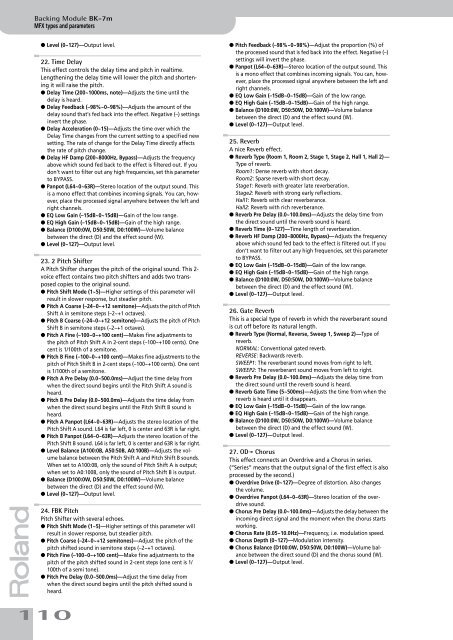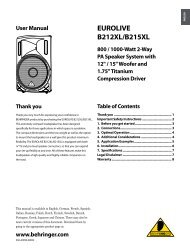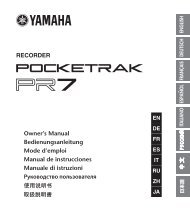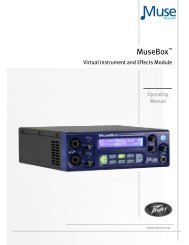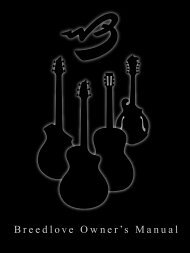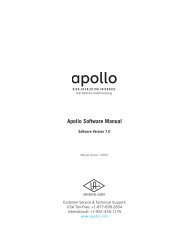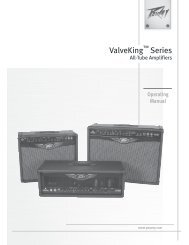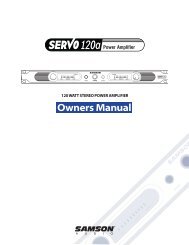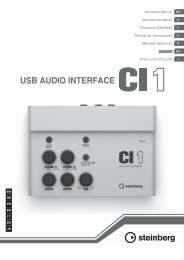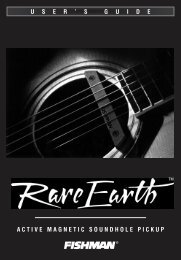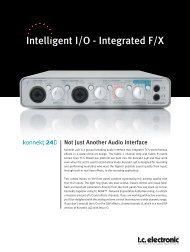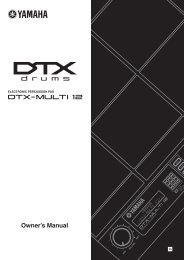You also want an ePaper? Increase the reach of your titles
YUMPU automatically turns print PDFs into web optimized ePapers that Google loves.
Backing Module <strong>BK</strong>-<strong>7m</strong><br />
MFX types and parameters<br />
r<br />
● Level (0~127)—Output level.<br />
22. Time Delay<br />
This effect controls the delay time and pitch in realtime.<br />
Lengthening the delay time will lower the pitch and shortening<br />
it will raise the pitch.<br />
● Delay Time (200~1000ms, note)—Adjusts the time until the<br />
delay is heard.<br />
● Delay Feedback (–98%~0~98%)—Adjusts the amount of the<br />
delay sound that’s fed back into the effect. Negative (–) settings<br />
invert the phase.<br />
● Delay Acceleration (0~15)—Adjusts the time over which the<br />
Delay Time changes from the current setting to a specified new<br />
setting. The rate of change for the Delay Time directly affects<br />
the rate of pitch change.<br />
● Delay HF Damp (200~8000Hz, Bypass)—Adjusts the frequency<br />
above which sound fed back to the effect is filtered out. If you<br />
don’t want to filter out any high frequencies, set this parameter<br />
to BYPASS.<br />
● Panpot (L64~0~63R)—Stereo location of the output sound. This<br />
is a mono effect that combines incoming signals. You can, however,<br />
place the processed signal anywhere between the left and<br />
right channels.<br />
● EQ Low Gain (–15dB~0~15dB)—Gain of the low range.<br />
● EQ High Gain (–15dB~0~15dB)—Gain of the high range.<br />
● Balance (D100:0W, D50:50W, D0:100W)—Volume balance<br />
between the direct (D) and the effect sound (W).<br />
● Level (0~127)—Output level.<br />
23. 2 Pitch Shifter<br />
A Pitch Shifter changes the pitch of the original sound. This 2-<br />
voice effect contains two pitch shifters and adds two transposed<br />
copies to the original sound.<br />
● Pitch Shift Mode (1~5)—Higher settings of this parameter will<br />
result in slower response, but steadier pitch.<br />
● Pitch A Coarse (–24~0~+12 semitone)—Adjusts the pitch of Pitch<br />
Shift A in semitone steps (–2~+1 octaves).<br />
● Pitch B Coarse (–24~0~+12 semitone)—Adjusts the pitch of Pitch<br />
Shift B in semitone steps (–2~+1 octaves).<br />
● Pitch A Fine (–100~0~+100 cent)—Makes fine adjustments to<br />
the pitch of Pitch Shift A in 2-cent steps (–100~+100 cents). One<br />
cent is 1/100th of a semitone.<br />
● Pitch B Fine (–100~0~+100 cent)—Makes fine adjustments to the<br />
pitch of Pitch Shift B in 2-cent steps (–100~+100 cents). One cent<br />
is 1/100th of a semitone.<br />
● Pitch A Pre Delay (0.0~500.0ms)—Adjust the time delay from<br />
when the direct sound begins until the Pitch Shift A sound is<br />
heard.<br />
● Pitch B Pre Delay (0.0~500.0ms)—Adjusts the time delay from<br />
when the direct sound begins until the Pitch Shift B sound is<br />
heard.<br />
● Pitch A Panpot (L64~0~63R)—Adjusts the stereo location of the<br />
Pitch Shift A sound. L64 is far left, 0 is center and 63R is far right.<br />
● Pitch B Panpot (L64~0~63R)—Adjusts the stereo location of the<br />
Pitch Shift B sound. L64 is far left, 0 is center and 63R is far right.<br />
● Level Balance (A100:0B, A50:50B, A0:100B)—Adjusts the volume<br />
balance between the Pitch Shift A and Pitch Shift B sounds.<br />
When set to A100:0B, only the sound of Pitch Shift A is output;<br />
when set to A0:100B, only the sound of Pitch Shift B is output.<br />
● Balance (D100:0W, D50:50W, D0:100W)—Volume balance<br />
between the direct (D) and the effect sound (W).<br />
● Level (0~127)—Output level.<br />
24. F<strong>BK</strong> Pitch<br />
Pitch Shifter with several echoes.<br />
● Pitch Shift Mode (1~5)—Higher settings of this parameter will<br />
result in slower response, but steadier pitch.<br />
● Pitch Coarse (–24~0~+12 semitones)—Adjust the pitch of the<br />
pitch shifted sound in semitone steps (–2~+1 octaves).<br />
● Pitch Fine (–100~0~+100 cent)—Make fine adjustments to the<br />
pitch of the pitch shifted sound in 2-cent steps (one cent is 1/<br />
100th of a semi tone).<br />
● Pitch Pre Delay (0.0~500.0ms)—Adjust the time delay from<br />
when the direct sound begins until the pitch shifted sound is<br />
heard.<br />
110<br />
● Pitch Feedback (–98%~0~98%)—Adjust the proportion (%) of<br />
the processed sound that is fed back into the effect. Negative (–)<br />
settings will invert the phase.<br />
● Panpot (L64~0~63R)—Stereo location of the output sound. This<br />
is a mono effect that combines incoming signals. You can, however,<br />
place the processed signal anywhere between the left and<br />
right channels.<br />
● EQ Low Gain (–15dB~0~15dB)—Gain of the low range.<br />
● EQ High Gain (–15dB~0~15dB)—Gain of the high range.<br />
● Balance (D100:0W, D50:50W, D0:100W)—Volume balance<br />
between the direct (D) and the effect sound (W).<br />
● Level (0~127)—Output level.<br />
25. Reverb<br />
A nice Reverb effect.<br />
● Reverb Type (Room 1, Room 2, Stage 1, Stage 2, Hall 1, Hall 2)—<br />
Type of reverb.<br />
Room1: Dense reverb with short decay.<br />
Room2: Sparse reverb with short decay.<br />
Stage1: Reverb with greater late reverberation.<br />
Stage2: Reverb with strong early reflections.<br />
Hall1: Reverb with clear reverberance.<br />
Hall2: Reverb with rich reverberance.<br />
● Reverb Pre Delay (0.0~100.0ms)—Adjusts the delay time from<br />
the direct sound until the reverb sound is heard.<br />
● Reverb Time (0~127)—Time length of reverberation.<br />
● Reverb HF Damp (200~8000Hz, Bypass)—Adjusts the frequency<br />
above which sound fed back to the effect is filtered out. If you<br />
don’t want to filter out any high frequencies, set this parameter<br />
to BYPASS.<br />
● EQ Low Gain (–15dB~0~15dB)—Gain of the low range.<br />
● EQ High Gain (–15dB~0~15dB)—Gain of the high range.<br />
● Balance (D100:0W, D50:50W, D0:100W)—Volume balance<br />
between the direct (D) and the effect sound (W).<br />
● Level (0~127)—Output level.<br />
26. Gate Reverb<br />
This is a special type of reverb in which the reverberant sound<br />
is cut off before its natural length.<br />
● Reverb Type (Normal, Reverse, Sweep 1, Sweep 2)—Type of<br />
reverb.<br />
NORMAL: Conventional gated reverb.<br />
REVERSE: Backwards reverb.<br />
SWEEP1: The reverberant sound moves from right to left.<br />
SWEEP2: The reverberant sound moves from left to right.<br />
● Reverb Pre Delay (0.0~100.0ms)—Adjusts the delay time from<br />
the direct sound until the reverb sound is heard.<br />
● Reverb Gate Time (5~500ms)—Adjusts the time from when the<br />
reverb is heard until it disappears.<br />
● EQ Low Gain (–15dB~0~15dB)—Gain of the low range.<br />
● EQ High Gain (–15dB~0~15dB)—Gain of the high range.<br />
● Balance (D100:0W, D50:50W, D0:100W)—Volume balance<br />
between the direct (D) and the effect sound (W).<br />
● Level (0~127)—Output level.<br />
27. OD‰ Chorus<br />
This effect connects an Overdrive and a Chorus in series.<br />
(“Series” means that the output signal of the first effect is also<br />
processed by the second.)<br />
● Overdrive Drive (0~127)—Degree of distortion. Also changes<br />
the volume.<br />
● Overdrive Panpot (L64~0~63R)—Stereo location of the overdrive<br />
sound.<br />
● Chorus Pre Delay (0.0~100.0ms)—Adjusts the delay between the<br />
incoming direct signal and the moment when the chorus starts<br />
working.<br />
● Chorus Rate (0.05~10.0Hz)—Frequency, i.e. modulation speed.<br />
● Chorus Depth (0~127)—Modulation intensity.<br />
● Chorus Balance (D100:0W, D50:50W, D0:100W)—Volume balance<br />
between the direct sound (D) and the chorus sound (W).<br />
● Level (0~127)—Output level.


